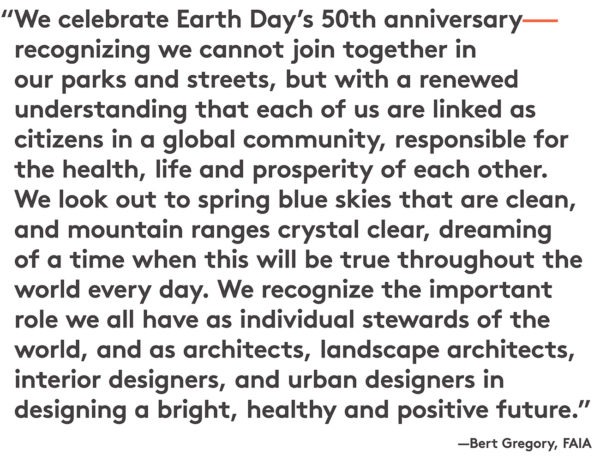Date Posted: 04.22.2020

On this unique Earth Day, we look back at the event’s history, Northwest roots and continued influence on the sustainable design movement.
INSPIRATIONS AND ORIGINS
The 1962 publication of Rachel Carson’s seminal book Silent Spring, describing the impacts of pesticides, is often cited as the beginning of the modern environmental movement in the United States. Sustainability, interest in organic foods, chemical health impacts, and pollution concern continued to gain steam throughout the 1960s. Growing concern about air and water pollution had spread in the wake of disasters including an offshore oil rig that spilled millions of gallons of oil onto California beaches and the sight of the contaminated Cuyahoga River, near Cleveland, Ohio, spontaneously bursting into flames.
Earth Day was the brainchild of Senator Gaylord Nelson of Wisconsin, a staunch environmentalist who hoped to provide unity to the grassroots environmental movement and increase ecological awareness. It was at the University of Washington that Nelson called for a national “college environmental teach-in.”
“The objective was to get a nationwide demonstration of concern for the environment so large that it would shake the political establishment out of its lethargy,” Senator Nelson said, “and, finally, force this issue permanently onto the national political agenda.”
On April 22, 1970, some 20 million Americans participated in marches and events across the country to demonstrate their support for a healthy, sustainable environment. This first Earth Day indeed increased environmental awareness in America, and in July of 1970 the Environmental Protection Agency (EPA) was established by President Richard Nixon to regulate and enforce national pollution legislation. This executive order also directed several actions including for the improvement of water treatment facilities, national air quality standards, stringent guidelines to lower motor vehicle emissions, proposing a tax on lead additives in gasoline, seeking legislation to end the dumping of wastes into the Great Lakes, and a National Contingency Plan for the treatment of oil spills. Earth Day also led to the passage of the Clean Water Act, Toxic Substances Control Act, and Endangered Species Act—critical milestones in safeguarding human and environmental health.
NORTHWEST LEADERS
Leadership of that first Earth Day came from a Pacific Northwest native, Denis Hayes. His passion and leadership around environmental causes, renewable energy and sustainability has changed the world for the better. He grew up in Camas, Washington and left his studies at Harvard after being selected by Senator Nelson to organize the inaugural Earth Day in 1970. Denis later graduated from Stanford, became head of the Solar Energy Research Institute (now known as the National Renewable Energy Laboratory), and eventually President of the Bullitt Foundation. He founded the Earth Day Network and expanded it to more than 180 nations.
The EPA’s first Administrator, William Ruckelshaus, has Northwest links and took the oath of office on December 4, 1970. Ruckelshaus moved to Seattle in 1974 and continued a legacy of improving global environmental health. President Ronald Reagan tapped Ruckelshaus again as EPA Administrator in 1983-1995. President Bill Clinton appointed him as a member of the President’s Council for Sustainable Development from 1993 to 1997, and as U.S. special envoy in the implementation of the Pacific Salmon Treaty from 1997 to 1998. He was appointed Washington State’s Chairman of the Salmon Recovery Funding Board and by President George W. Bush to serve on the United States Commission on Ocean Policy. He furthered his public service as Chair of the Advisory Board of The William D. Ruckelshaus Center at the University of Washington and Washington State University, focusing on collaborative public policy.

A GROWING MOVEMENT
Ecologically based design and the green building movement emanated in the 1960’s, with influences from Silent Spring, and highlighted by the first Earth Day. A focus on environmental issues and solar energy swept through design schools and throughout the world. In 1969, Ian McHarg published Design with Nature, a revolutionary book that fundamentally impacted design and land use planning throughout the world. Operating Manual for Spaceship Earth by R Buckminster Fuller was also published in 1969, as the first photos of the blue planet came from the moon. Architecture and urban design schools at several universities even changed their names to the college of environmental design, recognizing systems-based thinking. Awareness was raised, and with the oil crisis of the 1973, a solar energy revolution was born.
Denis Hayes sums it up: “Earth Day gathered up those strands, and dozens more, and knitted them together in the public consciousness as ‘environmental’ issues. The nation was pretty startled when 20 million people hit the streets. Congress, which had adjourned for the day to go back to its districts, was blown away.”
The importance of Earth Day spans generations and continents. One in 10 Americans participated in that first Earth Day in 1970. On April 22, 1990, the 20th anniversary of Earth Day, more than 200 million people in 141 countries participated in Earth Day celebrations. The Paris Climate Accords was signed by 174 nations at the United Nations on Earth Day 2016.
LOOKING FORWARD
We celebrate Earth Day’s 50th anniversary recognizing we cannot join together in our parks and streets, but with a renewed understanding that each of us are linked as citizens in a global community, responsible for the health, life and prosperity of each other. We look out to spring blue skies that are clean, and mountain ranges crystal clear, dreaming of a time when this will be true throughout the world every day. We recognize the important role we all have as individual stewards of the world, and as architects, landscape architects, interior designers, and urban designers in designing a bright, healthy and positive future.
Featured graphics were designed by Mithun’s Sean Anderson and Darin Vieira, top to bottom.